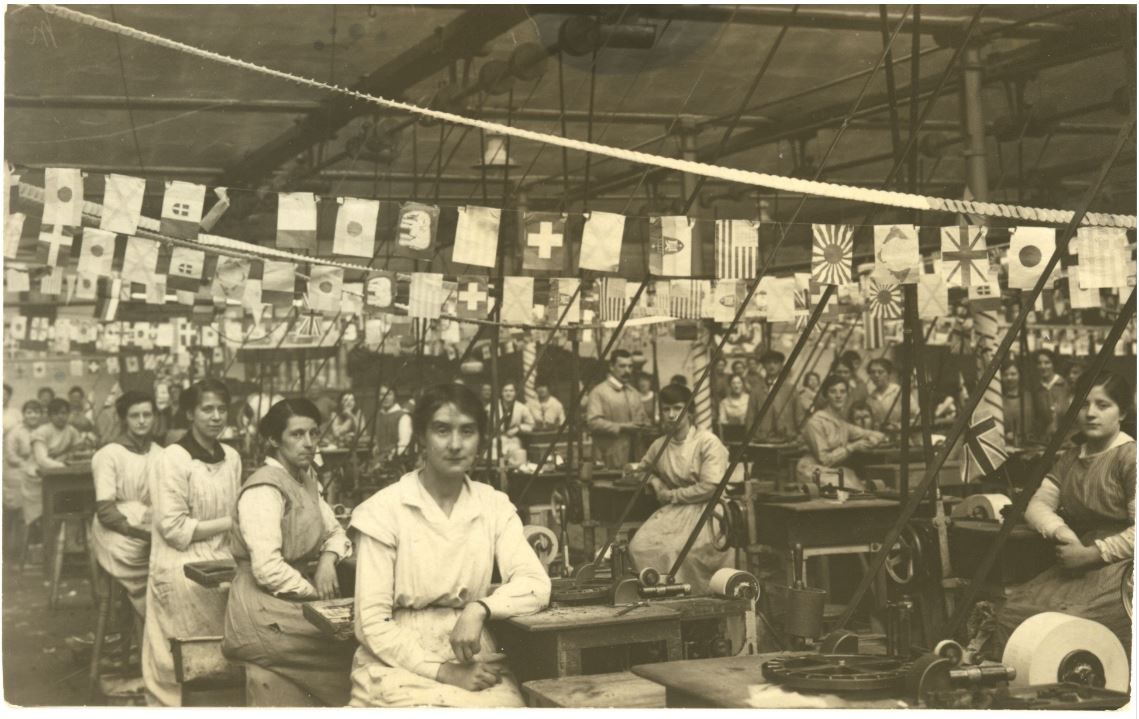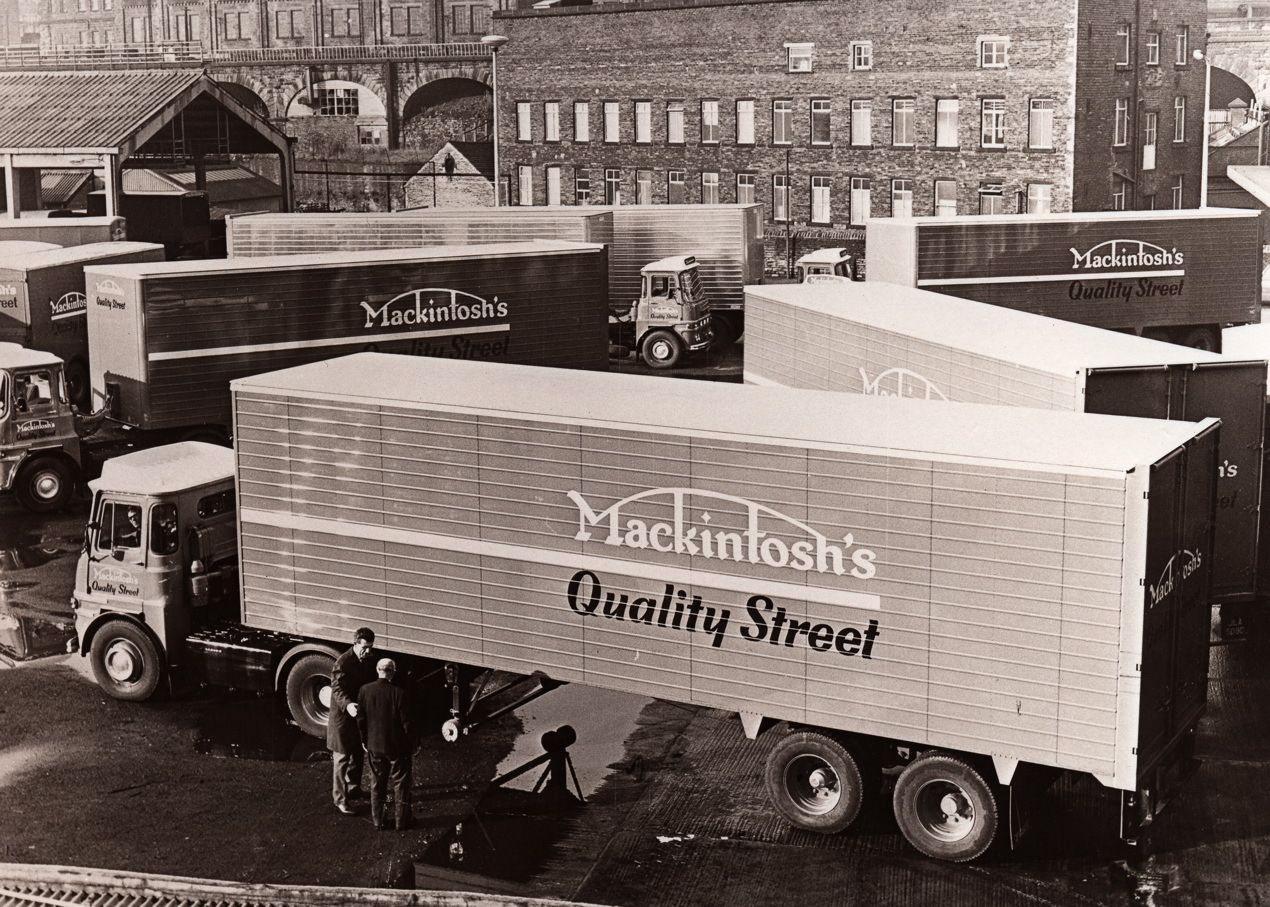Wrapper’s delight
You know Christmas is around the corner when the classic purple tins pop their lids in offices and homes across the country, but do you know the history of Quality Street?
It’s one of the first indications that Christmas is on the horizon: boxes of Quality Street stacked high in supermarket doorways while shop managers dig out the Christmas compilations album ready for another year of festive footfall.
“The Mackintoshes changed people’s perceptions of factory work, making it a fantastic career.”
In December the classic purple boxes can be spotted everywhere – on hospital wards, in office buildings, on perfume stands in department stores, on teachers’ desks and in hair salons. And on the 25th, approximately three hours after the collective scoff on turkey and After Eights, the sound of lids being peeled back and the rustling of wrappers can be heard in every living room across the country as hands delve in to dig out a trusty old toffee penny or green triangle.
The Nestlé product is synonymous with Christmas. In the run-up to the festive period the Quality Street factory produces more than 10 million sweets a day, with workers on the production line preparing Christmas stock as early as March.
It is the world’s number one selling chocolate assortment and is exported to over 50 countries across the globe, and it all started in Yorkshire.
The story of Quality Street is one of humble beginnings. In 1890 newly married couple John and Violet Mackintosh opened a pastry shop in King Cross Lane in Halifax, using their £100 savings. While John continued to work at the cotton mill, Violet, who had previously been a confectioner’s assistant, ran the shop. It was there she came up with the idea of blending brittle English toffee and soft American caramel.
The couple started selling Mackintosh’s Celebrated Toffee as a weekend treat, with John targeting the Saturday afternoon market, when workers had a half-holiday and their weekly wage payment in hand.
Violet didn’t know it at the time, but what she had concocted would ultimately transform the meaning of the word “toffee”, which had previously been a description of any sugar or boiled sweet. Nevertheless, it was John who took the credit. By 1896, Mackintosh was calling himself the Toffee King and his product the King Of All The Toffees.
Historian Alex Hutchinson has been working in the Mackintosh factory archives for 13 years. Hutchinson argues that it was a reluctant marketing choice by Mackintosh to take the credit for his wife’s work.
“Violet Mackintosh invented the original recipe for the toffee. Her husband was embarrassed about it but everybody credited him, and it really wasn’t until long after her death that her family started to talk about the fact that she had invented the toffee,” she says. “Violet cared about what she had achieved. She was a lady who was creative and an innovator, and part of that Mackintosh legacy, but she didn’t take the credit during her lifetime. She gave it her husband and apparently he was embarrassed to take it but it was what their publicists at the time recommended.”
The Mackintoshes’ legacy is one that stretches beyond the sweet factory. As the company moved from retail to manufacture and wholesale, employing staff to mass produce its prized product, it implemented a series of initiatives that changed the face of factory work.
“I would say that the Mackintoshes changed people’s perceptions of factory work, making it a fantastic career,” says Hutchinson. “The factory work of the early Industrial Revolution would sometimes be feared. The Mackintoshes were doing something different. They were trying to empower their workforce to be more creative and to use their initiative to be innovators.”
Over in York, another sweetie family was looking at ways to make life better for its workers. The Rowntrees, who went on to become instrumental in the formation of the welfare state, created the first scientifically calculated living wage, prioritised safety of employees in the workplace, offered workplace pensions, sick pay and paid holidays, and built houses in an effort to eradicate poverty among their staff.
Although they were competitors, the Rowntrees and the Mackintoshes were doing things differently. Hutchinson says the differences between the two companies were laid bare when their salesmen went out on the road.
“Everybody said the difference between the Mackintosh salesmen and the Rowntree salesman was that the Mackintosh salesmen would leave their hats on the back seat of the car and not bother wearing it, and their jacket would be off and they would go in with their sleeves rolled up and say, can I build you a window display? They built the best window displays. The Mackintoshes were very hands on and creative – it was a hotbed of innovation and creativity – whereas the Rowntrees were there to tick their sales off a list.”
An example of how the Mackintoshes encouraged their workers to play an active role in the future of the company came in the form of the world’s first twist-and-wrap machine, which was developed by workers on the production line.
“When you think of Rolo and how that’s like a sweet rolled into a piece of paper, that was invented by Mackintoshes as well. But it was the workers on the production line who were innovating,” says Hutchinson.
“There are lots of different ways of improving a workplace: one is empowering people to be creative and enjoy their work that way; another is to look at the rules and regulations and to make those work in the favour of the workforce. So both the Rowntrees and the Mackintoshes did slightly different things but they were both working to make factory work meaningful, enjoyable, safe, well paid and fulfilling.”

It is fair to say it was a stroke of marketing genius that led to the creation of Quality Street. By the 1930s John and Violet Mackintosh’s son Harold was in charge of the business. At a time when only the wealthy could afford boxed chocolate, which was made using expensive, imported ingredients, Harold set out to produce boxes of chocolates that could be sold at a reasonable price and would therefore be available to working-class families. His idea was to cover toffee, which could be made cheaply, with chocolate and present the sweets in individually wrapped paper and a decorative tin.
The first tins hit the shelves in May 1936, and the rest is history. By the Second World War the Quality Street brand was so embedded in the national consciousness that posters were put up assuring the nation that after the blackout they would have something to look forward to – sharing a tin of Mackintosh’s Quality Street with their loved ones.
In 1969 Yorkshire’s two confectionary dynasties joined forces and became Rowntree Mackintosh Confectionery before the company was taken over by Nestlé in 1988.
Today the former Mackintosh factory employs 700 staff, some of whom are third and fourth generation workers. Chris Atkinson, Nestlé’s apprenticeship, communications and engagement manager, says the Mackintosh principles of social responsibility and employee empowerment are at the forefront of how the business is run today.
All staff are given two days paid leave every year to volunteer at a local charity, and Atkinson says the Mackintosh family’s keenness to involve their workers in new developments has been passed down to its current workforce.
“When we look at new products we like to get feedback from people about what they would like,” he says. “The magic for us when we are making something new is involving as many people as we can, so we use all of their strengths and all of their knowledge and passion to bring that new product out.”
The legacies of the Rowntrees and Mackintosh families can be seen in every sweet shop in the country, but Hutchinson says it is Yorkshire and its people who paved the way for the families’ successes.
“I think they [the factories] are quintessentially Yorkshire. The Rowntrees were Quakers and Yorkshire is a Quaker stronghold, and the work that they were doing was experimenting with employee welfare. They found that York as a city was perfectly representative of the rest of the country because it had the same ratio of working-class people, middle-class people and upper-class people as the rest of the nation, and it was perfect for the work that they wanted to do. They could get lots of people willing to do factory work, working-class employees, but they were also able to retain some of the brightest minds in the country on economics and workplace psychology and that kind of thing, so they could do all of the workplace experiments they wanted to.
“And the Mackintoshes – well you need a certain type of determination to be an inventor, and the Mackintoshes were inventors. You also need a lot of common sense and the eye of an engineer, and I personally believe that people in West Yorkshire are just perfect for innovating. There’s something about the West Yorkshire attitude.”
Hutchinson has recently released a novel set on the Quality Street production line in the run-up to the product’s first Christmas. The Quality Street Girls, written under pen name Penny Thorpe, follows the lives of the women workers who helped to shape the future of the company. During her research Hutchinson interviewed women who worked in the Rowntree and Mackintosh factories and says she was inspired by the real-life stories.
“There was one lady who I talked to and she used to go and dance to records in her lunch break,” says Hutchinson. “There was a room where you could go and take along your vinyl records and you could do a lunchtime dance. It’s just hilarious to me that we have lunches at our desks while staring at our emails, and the idea that we would all take our iPods and go and have a silent disco in a meeting room sounds fantastic. It was typical of those days.
“They all said that they loved the camaraderie and the friendships that they formed. I meet lots of ladies who talk about how on their first day at the factory they met someone who was starting on the same day who was their age and they have been friends for life. They talk about meeting their husbands on the production line and sending their children to go and work in the same place.”

Leave a reply
Your email address will not be published.